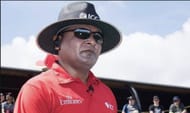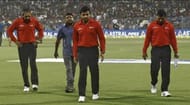
The seventh match between RCB and MI in the ongoing IPL saw a major howler by the umpire as a crucial no-ball was overlooked with RCB needing 6 off the last ball to take it to the super-over.
If the umpire was active or had even checked it with the 3rd umpire, the result could have entirely been different as AB de Villiers would take the strike on the final legal delivery. It is understood that the umpire even missed a couple of other no-balls and a wide in the match. If the international umpires from India are committing errors of this stature, then imagine the quality that is brewing at the local tournaments and in the division leagues.
The umpiring has been a concern from India’s perspective for quite some time now. India has failed to produce quality umpires over the years. On the other hand, every year Australia, England, and South Africa continue to keep producing high-quality umpires.
Despite being a powerhouse in world cricket, BCCI has somewhere failed in the umpiring domain. Even Pakistan and Srilanka have produced high-quality umpires that have won the “Umpire of the Year” several times.
Kumar Dharmasena is currently the active holder of the David Sheppard trophy. In the past, Aleem Dar from Pakistan has won the prestigious trophy for 3 continuous years.
To worsen things for BCCI and India, 23 out of 40 Umpires are set to retire within the next year due to the retirement policy of BCCI. The intricacies haven’t been looked carefully by the BCCI in the past and it might take a lot more time to improve the structure of umpiring at the very core.
So where does the fundamental problem lie with India that we aren’t able to produce high-quality international umpires despite being a powerhouse in world cricket?
#1 Carelessness from BCCI

Earlier this season when the Ranji Trophy ended, It was reported that 18 new umpires were hired for India’s premier domestic tournament without the mandatory medical test. The BCCI cited “lack of time” for skipping this important part of the procedure of recruitment. The umpires didn't undergo any kind of fitness tests, cardio tests for a tournament of such great importance.
These tests are of primary importance in the Australian Umpiring system. The Australian umpiring committee is very serious about tracking umpires' off-field factors such as mental health, fitness, nutrition, and sleep patterns. All the data and statistics are used to craft a comprehensive picture of an umpire's performance.
Of the 18 officials who did duty at the 2011 World Cup, five were from Australia - the largest representation by any nation on the tournament panel.
Currently, on the ICC’s elite panel there is only one Indian - S Ravi. He was the one who overlooked the Malinga no-ball.
Having umpires without tracking their off-field behaviors could mean a relaxation in the umpire’s attitude and will make them more prone to making mistakes. The Unfit umpires could get tired very soon in a 4-day long tournament and the ability to focus for longer periods of time will certainly not be ideal.
#2 Same salary structure for everyone

The BCCI has a 4-grade structure of dividing the umpires. Former and current ICC umpires take up the Grade A. The remaining 80% of the umpires are divided into Grade B, C and D depending on performance, experience, and various other factors.
The Grade-A officials get a total of ₹40,000 per day for officiating in First-class and List-A games while all the other grade umpires get ₹30,000
For example, even if an umpire officiating in a Ranji Trophy tournament has the poorest of the seasons and gets demoted to Grade C or Grade D, It wouldn’t matter much to him as the pay scale would still be the same and he will be officiating in much easier games with relatively lower pressure. The salary structure is designed in a way that keeps the umpires less motivated and no enthusiasm to end up in the top.
It is understood that Grade A and B umpires get to umpire in Ranji Trophy games and because of the pressure the teams exert, many umpires don’t mind officiating in a much lesser stress-free environment with the same pay scale.
The BCCI undoubtedly needs to restructure the pay-scale and make the higher grades more lucrative so that all the umpires strive to end up in the top tier.
#3 Not Having former players as umpires:

Many countries have made it mandatory now for the umpires to have played cricket at least at the first-class level. According to Cricket Australia's Umpire Educator Denis Burns, former cricketer turned umpires are able to go and "meet their mates who are still playing state cricket or even international cricket and say, 'Hey, I might have well given these guys some stick when I was playing but now, on the other side of the fence, I can tell you it is a bloody hard job.’"
Including former cricketers as a part of umpiring setup helps to improve the credibility and bridge the gap between the players and the umpires. The umpires will relate to what the players go through and can associate themselves with their situation.
Unfortunately, more than 50% of the Indian umpires haven’t played cricket at a professional level. There seems to be a change under Saba Karim, the General Manager of BCCI (Cricket Operations). He says that BCCI is open to former cricketers to have as umpires.
However, Karim and BCCI should make sure that the job is made lucrative for the former cricketers and attract more cricketers playing at the first class and List A level to take up umpiring post-retirement.
#3 Poor training academy

The BCCI had established the Nagpur National Umpiring Academy in 2010 to provide adequate training for umpires to improve their standards and reflexes. However from time and time again the academy has been sparingly used by the BCCI for its operations.
BCCI has been inconsistent with its training and has failed to provide proper umpiring courses. BCCI had a fallout with the Vidarbha Cricket Association and has a reason, it stopped using the services of the umpire academy established at Nagpur.
Though BCCI has started some level-1 courses involving former ICC Elite Panel Umpire Simon Taufel, a more frequent number of courses need to be conducted to improve the standard as a whole. More engagement programs with the Australian and England cricket board can be arranged as a part of this package
The BCCI also needs to make the entire process two-way. The umpires are often at the receiving end and most of the times, the umpires don't have a say in the coaching. A continuous feedback loop needs to be implemented for better end results.
#5 Lack of umpires

After the howler at the Chinnaswamy stadium in the match of RCB vs MI, one expected a strict action would be taken on the umpires. However, no actions will be taken on the umpires.
“Currently we have only 17 umpires assigned on-field and for third umpires’ duty. Out of them, 11 are Indian and six foreigners from the Elite Panel. Apart from them, we have six more Indians as fourth umpires,” a member was quoted saying to the TOI as reported by Sportstar.
So even when an umpire gives a howler of a decision, he can expect to get away with it easily due to lack of resources in India.
The BCCI is facing a shortage of good quality Umpires. India’s domestic season is the biggest in the world with over 2000 matches in a single season, so the BCCI is always forced to bring in new faces. More and more umpires with good theoretical knowledge end up on the field despite lesser practical experience. The number of applicants is less and as a reason, BCCI has to manage with sub-standard umpires.
#6 Respect

One of the primary reasons for less number of applicants is due to the stigma that exists in Indian cricket. Though a thankless job, not many want to have a career in umpiring. The public hardly recognizes any Indian umpire by his name and umpires are the ones given the least priority and respect in the sport of cricket.
Further, due to all the latest technology, the umpires are always under scrutiny by the players and the board. Not many survive the heat and quit at the early stages. As a reason, BCCI has always failed to produce top-notch umpires.
Its time the board, the players and the public give the respect the umpires deserve for their thankless job. It's also time the BCCI invest more time in umpiring, invest in HR potential and in the training and education of the umpires.
Get real-time updates on IPL 2025, live scores, IPL Prediction, match schedule, points table,Result & squad -CSK, MI, RCB, KKR, SRH, LSG, DC, GT, PBKS
